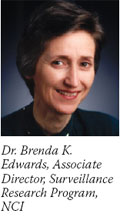
Guest Update by Dr. Brenda K. Edwards
SEER: Research Power in Numbers
 NCI's Surveillance Epidemiology and End Results (SEER) Program is a powerful cancer research tool that has served as the basis for thousands of studies. Innovative use of SEER data has produced additional statistics such as cancer prevalence, which is important to national estimates of cancer survivorship. NCI's Surveillance Epidemiology and End Results (SEER) Program is a powerful cancer research tool that has served as the basis for thousands of studies. Innovative use of SEER data has produced additional statistics such as cancer prevalence, which is important to national estimates of cancer survivorship.
Although many people equate SEER with the Annual Report to the Nation, the main reason for its popularity is rooted in the fact that SEER is the most comprehensive, population-based cancer registry in the world. It currently covers 26 percent of the U.S. population, and captures information on patient demographics, primary tumor site and morphology, stage at diagnosis, first course of treatment, and survival.
Since its establishment in 1973, SEER has constantly evolved to become more sophisticated and robust, while still maintaining - and enhancing - data confidentiality. For the past two decades, SEER has worked with the public and private sector, notably the North American Association of Central Cancer Registries, the American Cancer Society, the Commission on Cancer, and the Centers for Disease Control and Prevention to build a more cohesive national cancer registry system. In addition, the establishment of linkages between SEER data and Medicare records have opened up new avenues of cancer research that focus on treatment, particularly quality, patterns, and cost of care.
Quality control is a cornerstone of the SEER Program. In addition to extensive training courses for cancer registry professionals, Web-based tools are used for distance learning and to conduct reliability studies, the results of which are used to target future training and improve data quality. SEER also is applying contemporary information technology enhancements to improve efficiency, including a modular data management system and sophisticated tools for identifying cancer cases based on electronic capture of information in pathology records.
Such enhancements have helped make SEER a powerful research tool. We often call SEER a population-based laboratory, because it offers a massive population framework from which different types of vital studies can be conducted. The lead story in this week's issue of the NCI Cancer Bulletin highlights just such a study, with NCI researchers using SEER data to analyze the nonmedical costs of current cancer care.
In addition, since the 1990s, SEER has worked with the intramural and extramural research teams to conduct Rapid Response Surveillance Studies - investigations that can be performed in a relatively short period of time, typically 1 to 2 years. Numerous papers have been published based on these studies that address important questions about the dissemination of treatment advances in the community and other cancer control efforts that, in the absence of SEER, would take far longer to answer.
And, of course, a unique aspect of SEER that has made it a tremendous gateway for public health information is its public use file, available for analysis to users who agree to maintain confidentiality protections. The SEER Program has been at the forefront of providing access to cancer data for both public health professionals and the advocacy community through user-friendly analytical tools.
These are just a taste of the scope of the SEER Program and the vital research it supports. SEER continues to be an important resource for the public health community, using population-based science to have a significant impact on measuring our nation's progress in cancer prevention and treatment and guiding future directions for cancer research.
|